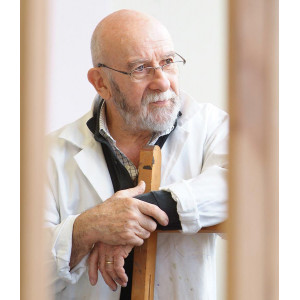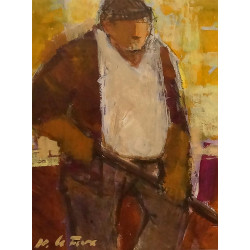
Jean-Pierre LE FÈVRE
Listed on the AKOUN
When his friends talk about him, they speak of the sensitivity, fragility and anguish that characterise Jean-Pierre LE FÈVRE as much as his obstinacy in finding the philosopher's stone of colour, the expression of the sensation...
From his Canteleu period (1961-1973), he offers luminous landscapes very close to the "School of Rouen". In 1982-1983, after the shock of his encounter with Japan, the colours, the graphics, the Orient, an Orient revisited afterwards during a trip to China, are lacquered colours, subtle flat tints, warm tones; facing Asia, Jean-Pierre LE FÈVRE finds serenity and a sense of matter, already a little eternity! Another temptation to escape is linked to his stays in the South, especially in Portugal!
The bright light of the South leads him to search for backlighting! The silhouettes sometimes become Giacometti-like figures, dark, black, standing out against the intensity of the warm colours of the landscape and giving it its tragic side! Le Fèvre's Portugal is however not far from his nostalgia for rural Normandy and the world of sailors, which has been anchored in him since childhood. He likes to rediscover the gestures, attitudes and ways of doing things, still preserved twenty years ago!
The human figure is very present in the work: many sketches crystallise snapshots of life, some result in astonishing paintings by their will to sublimate simple, almost frustrated beings, or very intimate attitudes! He observes the work, the gestures of the "humble life with boring and easy work" especially when this allows the movements to be inserted into the composition. In this series of figures often seen from behind or with voluntarily unfinished faces, it is a humanity that from Normandy to Asia is inserted in the grapes of light and colour to occupy the space.
The sources of the creation reveal the importance of the sketch, the richness of the studies, the sketches and the numerous drawings that nourish his compositions. They allow us to better situate Jean-Pierre Le Fèvre in the currents and styles of art! The complete vision of his creative process underlines indeed the capacity of synthesis of this figurative artist who is neither literally nor loaded! Comparing his drawings and paintings reveals a mutation, an abstraction of details, a domination of tones and colours over the form of the beginning. Certainly his drawing, his desire to capture the gesture, brings him closer to Jean-François Millet and therefore to tradition! His attention to everyday life, his nostalgia for his universe glimpsed during childhood, also brings him closer to this great, very great man of the 19th century.
Yet the "Le Fèvre style" reaches its full originality, its specificity in the alchemy of colour. The more he advances, the more his colours become inimitable, with all the science of the laboratories, he combines, he superimposes... his use of acrylic allows him virtuosity, nevertheless, when one approaches the work, the colours form a "patchwork" of infinite tones and nuances. The superimposition of tones brings us closer to medieval art. Acrylic paint creates the effects of Van Eyck's pre-Van Eyck painting, "Tempera". This is the secret of LE FÈVRE's modernity: the creation of new colours and tonal effects combined with the freedom of interpretation of the nature of the lissiers or glassmakers of the 15th and 16th centuries.
From his Canteleu period (1961-1973), he offers luminous landscapes very close to the "School of Rouen". In 1982-1983, after the shock of his encounter with Japan, the colours, the graphics, the Orient, an Orient revisited afterwards during a trip to China, are lacquered colours, subtle flat tints, warm tones; facing Asia, Jean-Pierre LE FÈVRE finds serenity and a sense of matter, already a little eternity! Another temptation to escape is linked to his stays in the South, especially in Portugal!
The bright light of the South leads him to search for backlighting! The silhouettes sometimes become Giacometti-like figures, dark, black, standing out against the intensity of the warm colours of the landscape and giving it its tragic side! Le Fèvre's Portugal is however not far from his nostalgia for rural Normandy and the world of sailors, which has been anchored in him since childhood. He likes to rediscover the gestures, attitudes and ways of doing things, still preserved twenty years ago!
The human figure is very present in the work: many sketches crystallise snapshots of life, some result in astonishing paintings by their will to sublimate simple, almost frustrated beings, or very intimate attitudes! He observes the work, the gestures of the "humble life with boring and easy work" especially when this allows the movements to be inserted into the composition. In this series of figures often seen from behind or with voluntarily unfinished faces, it is a humanity that from Normandy to Asia is inserted in the grapes of light and colour to occupy the space.
The sources of the creation reveal the importance of the sketch, the richness of the studies, the sketches and the numerous drawings that nourish his compositions. They allow us to better situate Jean-Pierre Le Fèvre in the currents and styles of art! The complete vision of his creative process underlines indeed the capacity of synthesis of this figurative artist who is neither literally nor loaded! Comparing his drawings and paintings reveals a mutation, an abstraction of details, a domination of tones and colours over the form of the beginning. Certainly his drawing, his desire to capture the gesture, brings him closer to Jean-François Millet and therefore to tradition! His attention to everyday life, his nostalgia for his universe glimpsed during childhood, also brings him closer to this great, very great man of the 19th century.
Yet the "Le Fèvre style" reaches its full originality, its specificity in the alchemy of colour. The more he advances, the more his colours become inimitable, with all the science of the laboratories, he combines, he superimposes... his use of acrylic allows him virtuosity, nevertheless, when one approaches the work, the colours form a "patchwork" of infinite tones and nuances. The superimposition of tones brings us closer to medieval art. Acrylic paint creates the effects of Van Eyck's pre-Van Eyck painting, "Tempera". This is the secret of LE FÈVRE's modernity: the creation of new colours and tonal effects combined with the freedom of interpretation of the nature of the lissiers or glassmakers of the 15th and 16th centuries.
Jean-Luc DUFRESNE (excerpts)
Doctor in Art History
Former curator of the Musée des Beaux-Arts de Saint-Lô











